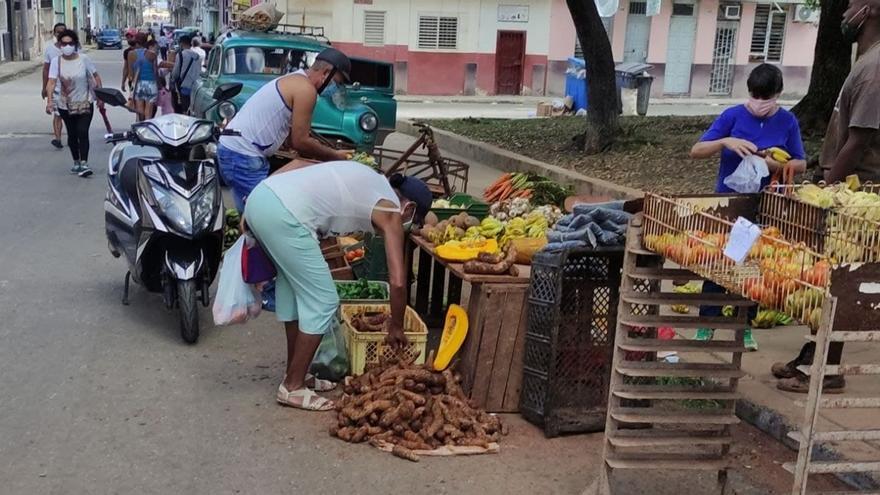
![]() 14ymedio, Madrid, 10 May 2022 — Pork production in Cuba fell by 53.5% in 2021 compared to the previous year, to just 132.9 tons. The collapse is not a surprise, but the publication this Monday of the food production data for the previous year has left a trail of bad news for the Government, since they confirm that, at least to date, the 63 measures designed to improve the industry have failed.
14ymedio, Madrid, 10 May 2022 — Pork production in Cuba fell by 53.5% in 2021 compared to the previous year, to just 132.9 tons. The collapse is not a surprise, but the publication this Monday of the food production data for the previous year has left a trail of bad news for the Government, since they confirm that, at least to date, the 63 measures designed to improve the industry have failed.
Bovine meat also fell, 13.5%, fresh milk by 16% and eggs by 10.5%. Poultry is another one that suffers the most, with a decrease of 20.8%, while mutton takes another hit, down 32.5%.
The report was released by the Cuban economist Pedro Monreal, who pointed out that these data are even more serious than those of agricultural products. In this subsector there is greater stagnation and only viands*, bananas and vegetables resist, but corn (7.2%), beans (7.3%), citrus (14.5%) and fruit trees (10.8%) fall. The worst blow, however, is for rice, the main ingredient in Cuban cuisine, which in 2021 barely produced 225.8 tons, 15.3% less than last year.
His colleague, also an economist residing in Spain, Elías Amor, has responded with a simple calculation. “With these data, the agricultural GDP in constant prices will have fallen by more than 15%, confirming the recession in the sector and the failure of the 63 measures.”
The drop in agricultural production in 2021 was expected, in the absence of official figures. The disaggregated data that was becoming known in each province did not bode well and the products, absent from market platforms, were enough for the population to know that the year was disastrous.
The pandemic, which during the summer of 2021 was especially harsh on the Island, did not help a broken system either, and the relief from US sanctions, long awaited by the authorities with Biden’s victory in the November 2020 elections, did not arrive.
The main solution for the authorities went through the vaunted 63 measures, announced in April 2021, which included reductions in electricity costs, the use of water, improvements in state payments, more attractive credits for the sector, the creation of a Agricultural Development Bank and a reform of the insurance system.
It also included, the famous package, relaxations for the sale of meat and dairy products. The possibility was opened for producers to sell their cheeses, yogurts and meats directly “even to stores [that take payment only] in freely convertible currency (MLC),” as long as they first comply with the delivery plan agreed with the State.
However, disagreements were not long in coming. The producers who managed to reach the desired figures lamented the lack of payment, either due to bureaucratic issues or due to the lack of liquidity that prevented them from obtaining the money in hard currency, more and more precious in the face of the collapse of the Cuban peso and the lack of a market in that currency.
In February of this year, the authorities considered that the measures were going well. “All the measures are important and have an impact on greater production in the country,” said the Minister of the Food Industry, Manuel Sobrino Martínez, who admitted that some productions had had a great decrease in recent years, such as milk, and for that reason prioritized measures included “livestock production and marketing policy.” The price of milk was even increased, months later, to try to stimulate the producer, but that has not worked either.
When evaluating the impact of the 63 measures, the authorities considered that the foundations had been laid and that efforts had to be made. Sobrino even added that it was necessary to achieve “control in the fulfillment of contracts based on the implemented policy” and that the other priority, without giving more details, “is political-ideological work.” But so far none of this has served to improve the indicators, and many Cubans wonder what good the food safety law that the government is preparing will do if it’s been decades since they haven’t been able to choose what they serve on their tables.
*Translator’s note: In Cuba “viand” refers to fruits and roots rich in carbohydrates, among which the best known are cassava, pumpkin, banana, potato, sweet potato and taro. (Source: ashepamicuba.com)
____________
COLLABORATE WITH OUR WORK: The 14ymedio team is committed to practicing serious journalism that reflects Cuba’s reality in all its depth. Thank you for joining us on this long journey. We invite you to continue supporting us by becoming a member of 14ymedio now. Together we can continue transforming journalism in Cuba.
